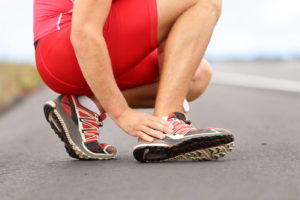Peroneal Tendonitis

The peroneal tendons are situated on the outside of the ankle and foot. These tendons originate from two muscles on the outside of the lower leg and help with movement of the foot and ankle. In addition, they are important in stabilizing the outside of the ankle and foot during walking and running.
What causes peroneal tendonitis?
The peroneal tendons are surrounded by a tunnel of soft tissue called a tendon sheath. A small amount of fluid in the tendon sheaths lubricate the tendons as they move back and forth during foot and ankle movement. When this lining becomes inflamed, it’s called tendonitis. The inflammation is caused by overuse of the tendons and in some cases ankle sprains. Some foot shapes such as high or low arches are more prone to peroneal tendonitis.
How is peroneal tendonitis diagnosed?
A good clinical examination and patient history are typically sufficient to make the diagnosis of peroneal tendonitis. Swelling is a common sign of peroneal tendonitis. Pain will be present along the outside of the ankle, heel, and foot. This pain is noticed when the foot is moved into an everted position (up and out). In addition, rolling onto the ball of the foot and climbing stairs can cause pain. In some cases, a clicking or popping sensation can occur on the outside of the ankle. This typically indicates the tendons are moving out of their normal position behind the outside ankle bone (lateral malleolus). When this occurs, it is called subluxing peroneal tendon syndrome. X-rays are often used to rule out bone spurs and arthritis that may be present. An MRI is ideal for a full evaluation of the tendon structure and to rule out tears or damage to the tendons.
How is peroneal tendonitis treated?
Treatment for peroneal tendonitis begins with inflammation which is best treated with ice and non-steroidal anti-inflammatory drugs (NSAIDs). Depending on the severity of the tendonitis, heel wedges, braces, splints, or cast boots may be necessary to reduce strain on the tendons. Physical therapy is often useful in treating the inflammation and to work on the biomechanics that played a role in the tendonitis. Custom foot orthotics have been show to effectively improve pain in some patients. In cases where the tendon is damaged, immobilization is important and surgery may be needed to repair a tear or remove inflammation from the tendon.
When can I return to running?
The goal of rehabilitation is return you to running as soon as is safely possible. If you return to a full training load too soon, the injury may return or worsen. Everyone recovers from injury at a different rate, so don’t compare your rehabilitation to other runners. Returning to running is determined by how well your tendons respond to treatment rather than a set number of days or weeks. In general, the longer you have had the symptoms, the longer it will take you to recover. Here are some general guidelines for a full return to running. Keep in mind, some runners may not have to completely stop running, but merely reduce their training load (distance, intensity, frequency) during the rehabilitation process.
- You should be able to bend and straighten your ankle without pain.
- Your ankle should not be swollen.
- You should be able to jog in a straight line without limping.
- You should be able to sprint without limping.
- You should be able to perform 45-degree and 90-degree cuts without difficulty.
- You should be able to jump on both legs without pain.
- You should able to jump on the injured foot and ankle without pain.
What can be done to reduce the chances of developing patellar tendonitis?
The most important factor in preventing patellar tendonitis involves addressing the root causes. So what are the root causes? It is generally accepted that more than half of all running injuries involve errors in training. This could include total mileage, running intensity, increasing the intensity and mileage too quickly, and finally the physical terrain (hills, trails, etc.). Improving areas of biomechanical deficiency also is important. This involves consistent focus on strength and flexibility of the hips and legs.
This information is not intended to diagnose, treat, or prevent any injury or disease. It is intended to serve as an overview of running-related injuries and should not be used as a substitute for sound medical advice from a doctor or therapist.


